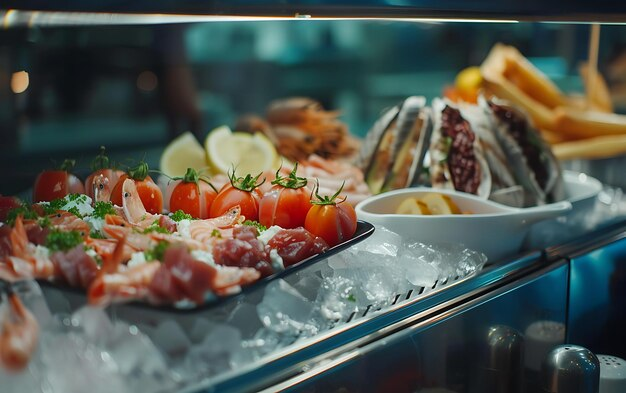52 9.2: Holding Food at Proper Temperatures
9.2 – Holding Food at the Proper Temperatures
Hot food holding equipment is designed to maintain cooked foods at safe temperatures above 135°F (57°C), effectively keeping them out of the bacterial “danger zone” where rapid pathogen growth occurs. Common examples include hot holding cabinets, steam tables, chafing dishes, and heat lamps. Hot holding cabinets typically feature heating elements combined with air circulation or humidity controls to preserve both the temperature and moisture of the food. It is important to note that these devices are intended solely for holding already cooked food at temperatures above 140°F (60°C) and are not meant for cooking or reheating. Consistent temperature monitoring is critical to ensure the safety of the food being held.
Cold food holding equipment serves to keep perishable items at or below 41°F (5°C), thereby inhibiting bacterial proliferation. Typical cold holding units encompass refrigerated display cases, ice-filled wells, refrigerated wells, ice pools, and ice plates. For optimal temperature control, these devices should be pre-chilled before food storage. Similar to hot-holding equipment, cold-holding units require routine temperature checks, and perishable foods should not be stored for extended periods but rather consumed within recommended safe time frames.
TCS foods must be held at 135°F (57°C) or above to inhibit pathogen growth and toxin production This temperature threshold ensures that potentially hazardous foods remain outside the “danger zone” where rapid microbial proliferation can occur . An exception is made for certain roasts, which may be held at a lower temperature of 130°F (54°C) if they have been cooked and reheated according to specific time and temperature parameters outlined in the Food Code (FDA).
Hot-Holding Guidelines
To ensure food safety during hot holding, it is important to regularly stir food to promote even heat distribution. Keeping the food covered helps retain heat and prevents contaminants from entering. According to official food safety standards:
- the internal temperature of hot-held foods should be checked at two-hour intervals using a food thermometer.
- Any hot food that has not been maintained at or above 135ºF (57.2ºC) for more than four hours must be discarded to avoid the risk of bacterial growth.
- It is critical to never use hot-holding equipment to heat or reheat food; foods must first be heated to the correct internal temperature for their specific type, typically ranging from 135ºF to 165ºF (57.2ºC to 73.9ºC) as outlined in cooking and reheating guidelines, before being placed in hot-holding units.
- Additionally, freshly prepared foods should never be combined with foods already in holding because this practice can introduce contamination.
Cold-Holding Guidelines
To inhibit the growth of harmful bacteria, cold time/temperature control for safety (TCS) foods must be maintained at 41°F (5°C) or below when they are not being actively prepared, cooked, or cooled.
Food protection from contamination can be achieved by covering items or employing food shields, as recommended by the FDA.
The internal temperature of these foods must be recorded every two hours, and prompt corrective measures should be taken if temperatures exceed 41ºF.

Image courtesy of Freepix
- It is advised never to store food directly on ice unless exceptions apply; generally, food should be placed in pans or on sanitized plates during display.
- The ice used in displays should be self-draining to avoid water accumulation, and all containers must be sanitized after each use.
Corrective Actions
The FDA and USDA recommend specific corrective actions when food temperatures fall outside safe ranges to prevent foodborne illness:
For hot foods held below the safe minimum temperature (usually below 135ºF or 140ºF):
- If the last temperature reading was above the critical limit within the last 2 hours, the food should be reheated to at least 165ºF for 15 seconds before placing back into hot holding.
- If the temperature has been below the safe limit for an unknown or longer duration, the food must be discarded.
- Equipment issues should be checked and fixed before returning food to hot holding.
For cold foods held above 41ºF:
- If the last temperature was below 41ºF within the last 2 hours, rapidly chill the food using appropriate methods (e.g., shallow containers, ice water bath, blast chiller) and repair or reset equipment if needed.
- If the food has been above 41ºF for an unknown or extended period, it must be discarded.
- During cooling, if foods are not cooled from 135ºF to 70ºF within 2 hours or to 41ºF within 6 hours (for most foods), corrective action includes reheating to 165ºF and then starting the cooling process again using a different method, or discarding the food if time limits are exceeded.
When there are doubts about the proper practice of hot or cold holding, the priority should always be food safety. Using clean and sanitized utensils and equipment is essential, and it is safer to discard any potentially hazardous food than risk consumer health. To minimize waste, it is advisable to prepare and cook only the amount of food that can be consumed within a short time frame.
Exceptions for Homogeneous Liquid TCS Foods
The Food Code allows for some flexibility in temperature control for homogeneous liquid TCS foods when they are contained within specially designed equipment. This exception recognizes advancements in food technology and equipment design that can maintain food safety through alternative means, as specified in section 4-204.13(E) of the Food Code to protect public health.
